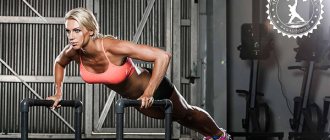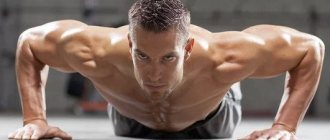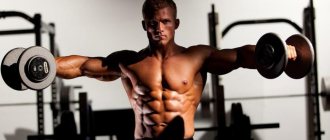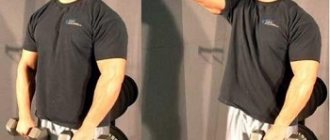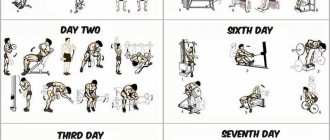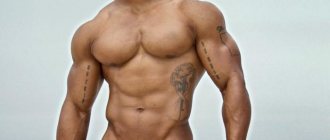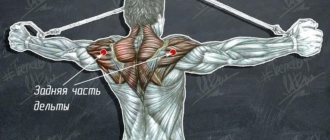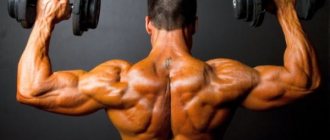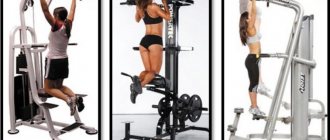A set of morning exercises for the muscles of the shoulder girdle and arms
Exercise “Ears”:
- Starting position: standing, feet shoulder-width apart, hands on the waist, looking forward. Execution: 1- tilt the head to the right shoulder without raising the shoulders. 2- return to the starting position. 3- tilt the head to the left shoulder without raising the shoulders. 4- return to starting position
Exercise “Birds”:
- Starting position: legs slightly apart, arms down, hanging along the body. Execution: spread your arms to the sides and wave them, alternating wide swings (“like an eagle”) and small ones (“like a sparrow”). Give up.
Exercise “The train is moving”:
- Starting position: legs slightly apart, arms hanging freely. Execution: bending and extending the arms at the elbows (we make circular movements, as if we were turning the wheels of a steam locomotive while moving).
Chin Pulls
Performing barbell rows to the chin
Want to know how to pump up your shoulders with dumbbells? Then you will need a barbell. In particular, barbell rows to the chin allow you to develop your trapezius and front deltoids. If you want to pump up your shoulders as much as possible, just increase your grip.
To perform this exercise, you should stand as straight as possible and grasp the barbell in your hands so that your palms face down. Now pull the barbell towards your chin while spreading your elbows out to the sides.
Similar to the previous one is the barbell row to the chest. Only in this case you do not reach the chin, but stop at chest level, slightly lingering at the top point.
Advice! The exercise should be performed with a wide grip.
How to perform a barbell row to the chest: arms at the top point are parallel to the floor
A set of morning exercises for the trunk muscles
Exercise “Birds are singing”:
- Starting position: legs spread wider than shoulders, arms down. Execution: bend forward, move your arms back, say “carr”, straighten to the starting position.
Exercise “Looking through the window”:
- Starting position: sitting on a chair, legs parallel, hands on knees. Execution: bend forward, bend your arms slightly at the elbows; turning your head left and right (as if looking out of a window). At the end of the exercise, straighten up.
Exercise “Ooh-sigh”
- Starting position: standing, feet shoulder-width apart, hands on the waist. Execution: 1-turn to the right, spread your arms to the sides, say: “Oh!” 2- return to the starting position. The same to the left.
Features of pumping the shoulder muscles
Pumping up the shoulder muscles with dumbbell swings
Today, there are various exercises for the shoulders at home. There are a very large number of them, but this does not mean that you necessarily need to do them all. In order to pump up the wide muscles quickly enough, you should choose 3-4 most suitable exercises.
Advice! Your training program must include exercises aimed at developing the front, middle and rear deltoids.
Typically a shoulder workout includes the following:
- presses;
- swings;
- traction.
About
Gymnastic exercises for the back of children 4-5 years old
Exercise "Who's there?"
Starting position: standing, hands on your belt, feet shoulder-width apart.
On the count of 1 ─ turn your head to the right;
2 ─ return to the starting position;
3 ─ turn your head to the left;
4 ─ return to starting position
Repeat this exercise 5 times
Exercise "Pendulum"
Starting position: standing, hands ─ on the waist, feet shoulder-width apart.
On the count of 1 ─ tilt your torso to the left;
2 ─ return to the starting position;
3 ─ body tilt to the right;
4 ─ return to starting position
Repeat this exercise 5 times.
Exercises for posture and sports will help strengthen the back muscles of children 4-5 years old.
Exercises for various types of osteochondrosis
Have you been trying to heal your JOINTS for many years?
Head of the Institute for Joint Treatment: “You will be amazed at how easy it is to heal your joints by taking every day...
Read more "
The development of osteochondrosis is fraught with serious complications for the body. Gradually, the vertebrae shift, squeezing numerous blood vessels and nerve endings. Dystrophic changes move to the nerve roots of the spinal cord. This leads to deterioration of blood supply and oxygen starvation. Osteochondrosis is difficult to treat with drugs if physical therapy is not included in it.
Exercise therapy as a method of treating osteochondrosis
Classes under the guidance of a doctor are carried out only at the initial stage. Next, the patient needs to exercise regularly at home.
Therapeutic gymnastics includes a number of complex and auxiliary gymnastic exercises. The main goal of therapy is to support muscle fiber and restore joint mobility through warming up the ligamentous apparatus. Physical therapy will be effective regardless of the severity of osteochondrosis, but it cannot be used as a single therapy.
Before starting exercise therapy classes
The gymnastics course does not require special training, but for greater effectiveness it is recommended to follow simple rules:
- To determine the severity of the musculoskeletal condition, it is necessary to undergo a thorough examination. This will allow you to exclude or confirm concomitant diseases for which exercise therapy is contraindicated.
- Health-improving exercises are performed at least twice a day - after waking up and before going to bed, always on an empty stomach and two hours before going to bed. One session should take about 25 minutes. If this is difficult at the initial stage, it is recommended to divide one session into two times with a break of 30 minutes. Gymnastics is not interrupted for one or two days, and physical activity is gradually increased.
- Before physical education, the practice room is ventilated and wet cleaned so that dust does not interfere with breathing. The optimal air temperature is 18-20 degrees. It is necessary to take into account that during exercise the body and joints will warm up. It is better to lay a light, lint-free rug on the floor; it should only be used for exercise therapy.
- With sports equipment, activities will be more varied. Some devices perfectly knead the core and have a better effect on muscle mass. In physical therapy, a large rubber ball, gymnastic stick or elastic band can be useful.
- For convenience and normalization of skin metabolic processes, wear comfortable clothes made of natural fabric. After exercise, the body is washed with not too cool water so that the heated muscles do not get cold.
- All exercises are done at a slow or medium pace; jerking, sudden stretching or falling are contraindicated. Breathing is not held; the reflex must be deep and smooth. The load is evenly distributed to all areas of the body, and there is a constant change in the movements of the limbs.
Exercises are not abandoned even after the symptoms of osteochondrosis disappear. Regularity is observed over a long period, preferably at certain hours.
Neck exercises
You must stand or sit straight on a chair. The arms relax and fall. The head turns alternately to the right and left. If intense pain persists and it is difficult to make turns, then you need to forcefully turn your neck with gentle jerks. You also need to do the following:
- A sitting position is assumed, the head is lowered down. Next, a downward movement is made with an attempt to pull the chin to the chest. The chest is not raised. You need to stay in this position for 10 seconds until tension appears in your neck. Chin tilts are repeated 5 times.
- In a sitting position, the arms relax, the chin retracts, and the head moves back with effort. Do 10 movements until you feel tension in the neck. The back muscles of the neck are gradually stretched, which is important for a sedentary lifestyle.
- In a sitting, straight position, the chin is raised and a palm is placed on the forehead. It must be pressed with force and held for 10 seconds. After the break, the exercise is repeated another 8-10 times. This tension gradually strengthens the front muscles of the neck and puts it in the correct position.
- When standing, your arms hang freely. The shoulders slowly rise to their maximum height and remain in this position for 10 seconds. Then the shoulders relax and a deep breath is taken. You need to feel how your hands are pulling your shoulders down. The exercise is repeated about 10 times.
You can perform exercises against cervical osteochondrosis along with this video.
Chest exercises
In a lying position, the arms are extended to the sides, the head is slightly raised along with the arms. You must remain in this position for 5 seconds. Next, the body returns to its original position. The gymnastics are repeated about 7 times. At the end, if you feel tired, you need to lie down for 5 minutes in a calm state with your arms outstretched, and there are also several other exercise options:
- Starting position: lying on your side. Then a slow rollover is made onto your back. The arms are extended as far as possible above the head. It is necessary to stretch, including tension in the chest. The shoulders are pulled back in this position.
- Lying on your stomach strains your shoulders, back and chest. At this moment, you need to try to bring your shoulder blades together for 10 seconds. After the exercise, the body relaxes as much as possible for 30 seconds, and then the movement is repeated.
- You need to lie on your back and roll over onto your left side, bending your knees. The right leg slowly straightens and rises. At the highest point, the position is delayed for several seconds. The muscles must be tensed until they stop. Then the starting position is assumed for 15 seconds. The exercise is repeated 4 times on one side and on the other.
- On the palace you need to kneel, relax and lower your hands. As you inhale, your arms slowly spread to the sides and move back, and your body bends at this moment. As you exhale, the body returns to its original position. Repeat 7 times.
Exercises for the lower back
With osteochondrosis, it is important to warm up your back. To do this, take a standing position, make torso turns and bends. Be sure to make circular movements clockwise. They make the lumbar region more mobile:
- The simple “cat” exercise develops muscles well and eliminates the symptoms of osteochondrosis. To do this, the knee-elbow position is assumed. The knees are spread shoulder-width apart. Slowly, as you inhale, bend your back down, lift your buttocks, and lower your chest toward the floor. Then the position slowly changes, the back arches, and the head bends under the arms. The exercise is done 5 times.
- You need to take a supine position. The legs are bent at the knees, and a medium-sized ball is placed between them. The feet and shoulder blades do not lift off the floor, and the buttocks slowly rise upward as you inhale. The movement is done 7 times.
- Lying on your back, legs bent at the knees. First, grab one knee and gently pull it towards your chest. Alternately bent legs are raised 7-10 times. After the exercise, the limbs are straightened, the body is fully tense and relaxed three times.
- After waking up, you need to grab the crossbar of the bed or sofa with your hands and try to pull up your body without using your legs. Exercise quickly activates the muscles. Repeat 5 times.
This video is for those who suffer from lumbar osteochondrosis.
When should you not do exercises?
Therapeutic exercise requires a certain load on the body. In some of its conditions this is strictly prohibited, but in most cases they are temporary or relative.
Contraindications:
- elevated temperature;
- acute infections or exacerbation of chronic pathologies;
- sudden internal or external bleeding;
- intoxication of the body;
- intense pain syndrome;
- malignant tumors;
- postoperative condition;
- attacks of high blood pressure.
Therapeutic exercise is designed to improve the patient’s condition and eliminate the obvious symptoms of osteochondrosis. According to statistics, patients who use daily exercises suffer less from pain and pinched nerves. Constant gymnastics promotes long-term remission of the disease.
The same banned issue for which Ernst fired Malakhov!
Joints and cartilage will be cured in 14 days with the help of ordinary...
Throughout life, the human spine and surrounding muscles serve to securely fix and protect the body, and also provide the opportunity to perform physical activity. In many ways, the health of the spine depends on the condition of the surrounding muscles and ligaments and, therefore, by playing sports or physical exercise for preventive purposes, a person protects his health in the future. The greatest effect in protecting muscles is provided by back exercises with dumbbells.
Both men and girls can play sports with dumbbells or a barbell; the main thing is to follow the recommendations and not create excessive stress on the muscles. In order to strengthen the muscle corset, you can attend a sports section, and for the treatment or prevention of spinal diseases, special physical education courses are recommended, which are performed at home.
Recommendations and restrictions
Before starting training with dumbbells or a barbell, it is necessary to undergo a comprehensive examination by a doctor in order to exclude serious chronic diseases, the presence of intervertebral hernias and other pathological processes in the spine and joints. The doctor will also recommend options for maximum load, weight restrictions for the muscles of the arms and back. In women, the early stage of pregnancy should be excluded, since exercises with a barbell or heavy dumbbells will be harmful to the child.
In general, each person can choose individual exercises and exercise regimen, but you need to adhere to the basic recommendations:
- You need to exercise regularly - several times a week or every other day, but without long absences.
- Women during menstruation should refrain from exercise.
- Classes should not last more than 40-50 minutes.
- Before exercises with dumbbells or a barbell, a warm-up is carried out for the muscles of the arms, legs, and back.
- The breathing rhythm should be smooth and not stray.
- If pain or dizziness occurs, the load should be reduced.
The exercises themselves are not performed at a fast pace; you should rest between approaches so as not to harm the body. You can exercise both while lying down, putting more stress on the muscles of the arms and shoulders, and while standing – strengthening the latissimus dorsi muscles, “wings”, and arms.
During intense exercise, the body burns a large number of calories, therefore, you need to monitor your diet. The diet includes more meat, fish, vegetables and fruits. Alcohol and smoking during periods of stress on the body have a negative effect, especially on the lungs and gastrointestinal tract, so you should wait a while with bad habits to achieve the effect.
There is a section of contraindications for exercising with dumbbells:
- cardiovascular pathologies (ischemia, consequences of heart attack, angina pectoris);
- chronic lung diseases (asthma, bronchitis);
- metabolic pathologies and cancer;
- menstruation period in girls, as well as pregnancy in women;
- people with restrictions on the load (the presence of a hernia, serious diseases of the spine, conditions after surgery or injury).
For this category of people, other options are selected for strengthening the muscles of the back and arms, including therapeutic exercises, massage, and yoga.
A set of exercises with dumbbells
For both women and men, the developed sets of exercises with dumbbells are performed after warming up the muscles of the back, arms and legs. To do this, bend forward, backward and to the sides, perform rotational movements with the arms, and, in general, any gymnastics techniques performed for 6-10 minutes are allowed.
It is important to remember that the weight of the dumbbells must match the person’s capabilities. So, for women, the approximate limit is 2-5 kilograms, while for men it all depends on the degree of preparedness and muscle development.
Let's look at how to pump your back with dumbbells. Basic exercises that can be performed at home:
- While lying on your stomach, your arms are extended forward. You need to raise your arms with dumbbells and bring them back, while your legs are slightly raised. The technique strengthens the latissimus, rectus dorsi muscles, shoulders and arms. Start with 7 repetitions, eventually increasing to 10-15.
- Standing position, bending your body forward so that it is parallel to the floor. Hands with dumbbells are lowered down. You need to lift the dumbbells towards your body so that your elbows are higher than your back. Do 10-15 dumbbell lifts. This technique can be performed in conjunction with a barbell. Both women and men should be able to do this exercise with ease; with its help, the muscles of the arms, “wings”, shoulders, shoulder blades, and partially the latissimus muscles are pumped.
- Lifting dumbbells with arm curls. These are basic techniques in any muscle pumping scheme, both with dumbbells and a barbell. For the best effect, it is advisable to lean on a chair with your arm and knee at home and bend your arm with dumbbells at the elbow. First, 10 lifts are performed with the right hand, after which the hands and position change. The muscles of the arms (biceps), “wings”, shoulders and shoulder blades are strengthened.
- This exercise is easy for women or girls, and for men it is prescribed for weakness in the muscles of the back and arms. In a standing pose, your arms should hang over the dumbbells. The shoulders fall and rise, but the arms themselves are relaxed. 10-15 approaches are performed.
In a lying position on the edge of the bed, techniques with moving the arms with dumbbells back and lifting them with bending the elbow are effective. This is how the latissimus dorsi muscles, shoulders and arms are pumped up well.
For the best effect, it is advisable to combine exercises with push-ups and push-ups. This strengthens all muscle groups of the back, including the “wings” and shoulders with arms.
A set of exercises with a barbell
In addition to the therapeutic effect, many women and men have a desire to have a beautiful and pumped up body. Therefore, if there are no contraindications and women are not pregnant, then barbell exercises can be added to exercises with dumbbells.
When performing exercises with a barbell at home in a lying position, it is recommended that someone be nearby and provide backup.
Almost all sets of exercises include the following basic techniques:
- In a standing position with the body bent parallel to the floor, the barbell is clasped with the hands and pulling movements are made to the chest from 5 to 10 times. This will pump up the latissimus muscles of the back, arms, and shoulders.
- Position as in technique No. 1. The arms with the barbell do not bend when performing the exercise. You need to do squats, bending only your knees. Doing the exercise strengthens the muscles of the lower back and buttocks.
- The exercise is done lying down. You need to place the barbell at chest level and lift it up with jerking movements. The exercise is performed slowly; there should be a person at home to provide backup when performing the lifts while lying down.
For many people, the most difficult muscles are the “wings” and the latissimus dorsi, as these muscles are powerful and require a lot of work.
Techniques for large back muscles
At home, if you have a barbell, you can pump up the “wings” by taking a standing position, with your knees slightly bent, your torso tilted forward and your head straight. The barbell is fixed in the lowered hands. With a tense back, you need to pull the barbell to your stomach while exhaling, raising your elbows high, and then lower your arms as you exhale. You need to perform the exercise 5-10 times together with other techniques.
You can strengthen the “wings” and latissimus muscles by pumping your back with dumbbells, leaning your left palm and knee on a chair. The right hand hangs down from the dumbbells, the body is tilted. As you exhale, you need to lift the dumbbell up until your elbow and shoulder are at the same level, and then, in this position, straighten your arm to the side. This exercise makes the “wings”, latissimus dorsi and arms work immediately. 5-10 techniques are performed on each side.
The best results are achieved by regular exercise in compliance with diet and rest.
2016-05-27
Reading on shoulders
Highly raised shoulders in combination with a slightly hunched back and retracted chin - helplessness, fear, nervousness, uncertainty.
Shoulders protruding forward - a feeling of weakness and depression, an inferiority complex.
Freely dropped shoulders - a feeling of confidence, control of oneself and the situation.
Shoulders laid back - determination to act actively, strength, enterprise, but at the same time - overestimation of one's own capabilities.
TEXT: Yulia Sivakova
Sedentary work does not spare the spine and we can see this every day - stooping, pain, stiffness of movement bother many - from schoolchildren to retirees. How to straighten your shoulders and return your back to normal? In this article we will present many useful and simple exercises that will help you maintain a healthy spine.
Exercise goals
Strengthening the muscles of the upper shoulder girdle is necessary for the following pathologies:
- osteochondrosis of the cervical spine;
- prolapse of intervertebral discs;
- consequences of a fracture of the collarbone or upper third of the shoulder;
- arthrosis of the shoulder joints;
- myodystrophies of various nature.
Exercise therapy helps well with lordotic or kyphotic curvature of the spinal column.
Physical therapy that uses the muscles of the shoulder girdle helps a person correct their posture and get rid of kyphosis or lordosis. At the same time, a stable muscle corset is formed, preventing hernias, dislocations and osteochondrosis of the spine. Due to the significant muscle volume, blood flow to the vital structures of the head increases, which helps get rid of headaches, dizziness and loss of consciousness. A set of exercises is also necessary during rehabilitation after injuries, fractures and dislocations of the upper limbs.
Exercise therapy for neck and shoulder pain
Before developing a set of physical exercises (physical exercises) for pain in the neck and shoulders, it is necessary to find out their etiology. Mainly the muscles of the neck and shoulder girdle hurt due to osteochondrosis. For this reason, in addition to performing exercises to strengthen the muscles of the neck and shoulder girdle, it is necessary to follow other doctor’s recommendations for treatment in order to achieve a speedy recovery and eliminate pain.
Osteochondrosis in the cervical region is primarily treated with pathogenetic therapy, which helps eliminate the underlying cause of the disease. In this case, it is advisable to systematically wear a Shants collar - a means that helps ensure complete rest of the affected part of the spine and prevent microtrauma of the nerve roots. Also, the use of a collar helps to reduce the pathological discharge of nerve impulses to healthy areas, namely, to the shoulder girdle.
Therapeutic exercise is prohibited during the main period of treatment of the disease, as well as any active exercises for the muscles of the neck and shoulders. During the recovery period, after the main treatment, gymnastics is allowed, which is aimed at strengthening the muscles of the neck (shoulders). Physical techniques for the neck muscles are carried out in conjunction with breathing exercises. It is recommended to pay special attention to the trapezius and deltoid muscles, which are most often involved in the lesion, while being in a state of hypertonicity.
Gymnastics for osteochondrosis of the neck and other pathologies helps not only improve blood circulation, reduce the likelihood of pain radiating from the site of injury to other areas, but also improve a person’s psycho-emotional state. If glenohumeral periarthritis occurs, exercise therapy helps reduce the intensity of pain in the shoulder and neck and prevent joint stiffness. With the development of vertebral artery syndrome, physical exercise can help relax the muscles of the neck, shoulders, and upper limbs, and improve coordination of movements.
In addition to the benefits of exercises that strengthen and relax the muscles of the back, neck, and shoulders, there are also disadvantages, which are expressed in the presence of contraindications for their implementation. So, the following are considered absolute contraindications:
- if the person’s condition is serious and there is an increased body temperature;
- if there is a violation of the blood circulation process in the brain;
- if the symptoms of the disease progress;
- if persistent pain syndrome is observed;
- if, due to compression syndrome, surgical intervention is required.
How to prevent shoulder and neck muscle pain?
How it is necessary to prevent pain syndrome in a particular case depends only on what reason caused it or can cause it. This includes both provoking factors, for example, sitting in a monotonous position for a long time, and diseases occurring in the body.
As a rule, the prevention of pain syndrome is as follows:
- sleep on a medium-hard mattress, on a small pillow;
- performing exercises after waking up;
- if discomfort occurs in the shoulder, neck or behind the neck, it is recommended to give them rest, limiting any stress;
- If a person’s profession requires him to be in a monotonous position for a long time, it is recommended to massage his shoulders and neck from time to time.
Pain syndrome in the shoulder and neck area is mainly a consequence of muscle overstrain for one reason or another. That is why it is recommended to systematically perform those exercises that help maintain their natural mobility. Only by strengthening the muscles of the shoulder girdle can you prevent pain in the future.
